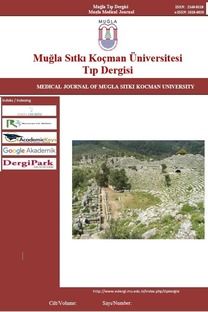Hiperbarik Oksijen Tedavisinin, Diyabetik Ayak Yarası Olan Hastalarda Hipoksiyle İndüklenen Faktör-1α, İndüklenebilir Nitrik Oksit Sentaz ve Vasküler Endotelyal Büyüme Faktörü Seviyeleri Üzerine Etkisi
Diyabetik Ayak, Hiperbarik Oksijen, Hipoksiyle İndüklenen Faktör, Yara İyileşmesi
The Effects of Hyperbaric Oxygen Treatment on Hypoxia Inducible Factor-1α, Inducible Nitric Oxide Synthase and Vascular Endothelial Growth Factor Levels in Patients with Diabetic Foot Wound
Diabetic Foot, Hyperbaric Oxygen, Hypoxia Inducible Factor, Wound Healing,
___
- 1. Palumbo PJ, Melton LJI. Peripheral vascular disease and diabetes. In National Diabetes Data Group (ed): Diabetes In America (NIH publ. no. 495-1468). 1995; 401-8. 2nd ed. Washington, DC, US. Government Printing Office.
- 2. Semenza GL. Perspectives on oxygen sensing. Cell. 1999;98(3):281-4.
- 3. Semenza GL. Hypoxia-inducible factor 1 and the molecular physiology of oxygen homeostasis. J Lab Clin Med. 1998;131(3):207-14.
- 4. Zhang Q, Chang Q, Cox RA, Gong X, Gould LJ. Hyperbaric oxygen attenuates apoptosis and decreases inflammation in an ishemic wound model. J Invest Dermatol. 2008;128(8):2102-12.
- 5. Halterman MW, Federoff HJ. HIF-1alpha and p53 promote hypoxia-induced delayed neuronal death in models of CNS ischemia. Exp Neurol. 1999;159(1):65-72.
- 6. Calvert JW, Cahil J, Yamaguchi-Okada M, Zhang JH. Oxygen treatment after experimental hypoxia-ischemia in neonatal rats alters the expression of HIF-1α and its downstream target genes. J Appl Physiol (1985). 2006;101(3):853-65.
- 7. Palmer LA, Semenza GL, Stoler MH, Johns RA. Hypoxia induces type II NOS gene expression in pulmonary artery endothelial cells via HIF-1. Am J Physiol. 1998;274(2 Pt 1):L212-9.
- 8. McCormick CC, Li WP, Calero M. Oxygen tension limits nitric oxide synthesis by activated macrophages. Biochem J. 2000;350(Pt 3):709-16.
- 9. Wiesener MS, Maxwell PH. HIF and oxygen sensing; as important to life as the air we breathe?. Ann Med. 2003;35(3):183-90.
- 10. Kang TS, Gorti GK, Quan SY, Ho M, Koch RJ. Effect of hyperbaric oxygen on the growth factor profile of fibroblasts. Arch Facial Plast Surg. 2004;6(1):31-5.
- 11. Gajendrareddy PK, Sen CK, Horan MP, Marucha, PT. Hyperbaric oxygen therapy ameliorates stres-impaired dermal wound healing. Brain Behav and Immun. 2005;19(3): 217-22.
- 12. Jude EB, Boulton AJ, Ferguson MW, Appleton I. The role of nitric oxide synthase isoforms and arginase in the pathogenesis of diabetic foot ulcers: possible modulatory effects by transforming growth factor beta 1. Diabetologia. 1999;42(6):748-57.
- 13. Yamasaki K, Edington HD, McClosky C et al. Reversal of impaired wound repair in iNOS-deficient mice by topical adenoviral-mediated iNOS gene transfer. J Clin Invest. 1998;101(5): 967-71.
- 14. Schäffer MR, Tantry U, Thornton FJ, Barbul A. Inhibition of nitric oxide synthesis in wounds: pharmacology and effect on accumulation of collogen in wounds in mice. Eur J Surg. 1999;165(3):262-7.
- 15. Schäffer MR, Efron PA, Thornton FJ, Klingel K, Gross SS, Barbul A. Nitric oxide, an autocrine regulator of wound fibroblast synthetic function. J Immunol. 1997;158(5):2375-81.
- 16. Schäffer MR, Tantry U, Efron PA, Ahrendt GM, Wasserkrug HL, Barbul A. Diabetes-impaired wound healing and reduced wound nitric oxide synthesis: a possible pathophysiologic correlation. Surgery. 1997;121(5):513-9.
- 17. Schäffer MR, Tantry U, Ahrendt GM, Wasserkrug HL, Barbul A. Acute protein-calorie malnutrition impairs wound healing: a possible role of decreased wound nitric oxide synthesis. J Am Coll Surg. 1997;184(1):37-43.
- 18. Cross RK, Wilson KT. Nitric oxide in inflammatory bowel disease. Inflamm Bowel Dis. 2003;9(3):179-89.
- 19. Takahashi T. Pathophysiological significance of neuronal nitric oxide synthase in the gastrointestinal tract. J Gastroenterol. 2003;38(5):421-30.
- 20. Sheikh AY, Gibson JJ, Rollins MD, Hopf HW, Hussain Z, Hunt TK. Effect of hyperoxia on vascular endothelial growth factor levels in a wound model. Arch Surg. 2000;135(11):1293-7.
- 21. Shenberger JS, Zhang L, Powell RJ, Barchowsky A. Hyperoxia enhances VEGF release from A549 cells via post-transcriptional processes. Free Radic Biol Med. 2007;43(5):844-52.
- 22. Zhang M, Liu S, Guan E et al. Hyperbaric oxygen therapy can ameliorate the EMT phenomenon in keloid tissue. Medicine (Baltimore). 2018; 97(29):e11529.
- 23. Lu Z, Ma J, Liu B et al. Hyperbaric oxygen therapy sensitizes nimustine treatment for glioma in mice. Cancer Med. 2016; 5(11):3147-55.
- ISSN: 2148-8118
- Yayın Aralığı: 3
- Başlangıç: 2014
- Yayıncı: Muğla Sıtkı Koçman Üniversitesi
İnsan Midesindeki Enteroendokrin Hücrelerin Histokimyasal ve İmmünhistokimyasal Olarak İncelenmesi
Okşan UYAR GAZEZOĞLU, Feral ÖZTÜRK, Hülya ELBE, Özgür İLHAN ÇELİK
Hiperammonemi Olmaksızın Valproik Asit ile İlişkili Ensefalopati Olgusu
Mahmut Bilal ÇAMAN, Ayşe Özlem AKGÜN, Semai BEK, Gülnihal KUTLU
Düzeltme: İntraperitonal PEG-4000 Uygulanmasının İnce Barsak Anastomozuna Etkileri: Deneysel Çalışma
Hepatorenal Sendromlu Bir Hastada Terlipressin Tedavisine İkincil Skrotal Nekroz
Volkan KARAKUŞ, Dilek Ersil SOYSAL
Egemen Kaya, Deniz AKPINAR, Havva AKPINAR
Emre GÜLTAÇ, Hıdır TANYILDIZI, Cem Yalın KILINÇ, Nevres Hürriyet AYDOĞAN
Yoğun Bakımda Eritrosit Transfüzyonunun Klinik Sonlanımlar Üzerine Etkisi
